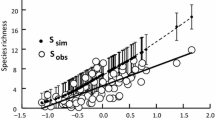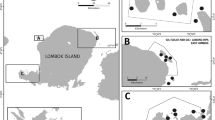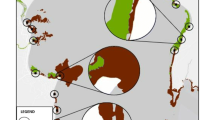Abstract
Habitat loss due to land reclamation often occurs in sandy coral reef shore zones. The giant sea anemone Stichodactyla gigantea, which harbors the false clown anemonefish Amphiprion ocellaris, both of which are potentially flagship species, inhabit these places. To assess habitat quality for S. gigantea, we examined correlative associations between the number and the body size of S. gigantea and the amount of habitat types in fine-scale seascape composition quantified from an enlarged section of a high-resolution (1/2,500) color aerial photograph of the shallow shore zone of Shiraho Reef, Ishigaki Island, Japan. This study confirmed that anemones were most abundant at the edges of dense seagrass beds characterized by shallow sandy bottoms, rock beds, and sparse seagrass beds, while they were less abundant in coral patch reefs. However, anemones inhabiting coral patch reefs were significantly larger and their rate of disappearance over 3 years was lower than those inhabiting other habitats. This suggests that coral patch reefs may be more suitable habitats supporting larger animals and greater persistence of S. gigantea. The visual census techniques applied here, combined with aerial photography and image-analysis software, may be useful as a simple analytical tool for local assessment of suitable habitats for relatively small-bodied marine fauna in shallow-water seascapes.





Similar content being viewed by others
References
Adams AJ, Dahlgren CP, Kellison GT, Kendall MS, Layman CA, Ley JA, Nagelkerken I, Serafy JE (2006) Nursery function of tropical back-reef systems. Mar Ecol Prog Ser 318:287–301
Bell JD, Galzin R (1984) Influence of live coral cover on coral-reef fish communities. Mar Ecol Prog Ser 15:265–274
Chave EH, Eckert DB (1974) Ecological aspects of the distributions of fishes at Fanning Island. Pac Sci 28:297–317
Dunn DF (1981) The clownfish sea anemones: Stichodactylidae (Coelenterata: Actiniaria) and other sea anemones symbiotic with pomacentrid fishes. Trans Am Phil Soc 71:1–115
Fautin DG, Allen GR (1992) Anemonefishes and their host sea anemones. Western Australian Museum, Perth
Grober-Dunsmore R, Kranzer TK, Lindberg WJ, Beets J (2007) Reef fish and habitat relationships in a Caribbean seascape: the importance of reef context. Coral Reefs 26:201–216
Hattori A (2002) Small and large anemonefishes can coexist using the same patchy resources on a coral reef, before habitat destruction. J Anim Ecol 71:824–831
Hattori A (2005) High mobility of the protandrous anemonefish Amphiprion frenatus: non-random pair formation in limited shelter space. Ichthyol Res 52:57–63. doi:10.1007/s10228-004-0253-3
Hattori A (2006) Vertical and horizontal distribution patterns of the giant sea anemone Heteractis crispa with symbiotic anemonefish on a fringing coral reef. J Ethol 24:51–58. doi:10.1007/s10164-005-0160-8
Hattori A, Kobayashi M (2007) Configuration of small patch reefs and population abundance of a resident reef fish in a complex coral reef landscape. Ecol Res 22:575–581. doi:10.1007/s11284-006-005-4
Irlandi EA (1994) Large- and small-scale effects of habitat structure on rates of predation: how percent coverage of seagrass affects rates of predation and siphon nipping on an infaunal bivalve. Oecologia 98:176–183
Irlandi EA, Ambrose WG, Orlando BA (1995) Landscape ecology and marine environment: how spatial configuration of seagrass habitat influences growth and survival of the bay scallop. Oikos 72:307–313
Japan Coral Reef Society and Ministry of the Environment (2004) Coral Reefs of Japan. Ministry of the Environment, Japan
Kobayashi M, Hattori A (2006) Spacing pattern and body size composition of the protandrous anemonefish Amphiprion frenatus inhabiting colonial host sea anemones. Ichthyol Res 53:1–6. doi:10.1007/s10228-005-0305-3
Lowe-McConnell RH (1987) Ecological studies in tropical fish communities. Cambridge University Press, Cambridge
Luckhurst BE, Luckhurst K (1978) Analysis of the influence of substrate variables on coral reef fish communities. Mar Biol 49:317–323
McCormick MI (1994) Comparison of field methods for measuring surface topography and their associations with a tropical reef fish assemblage. Mar Ecol Prog Ser 112:87–96
Mitchell JS (2003) Mobility of Stichodactyla gigantea sea anemones and implications for resident false clown anemonefish, Amphiprion ocellaris. Environ Biol Fish 66:85–90
Morisita (1959) Measuring of dispersion of individuals and analysis of the distributional patterns. Mem Facul Sci Kyushu Univ Ser E 2, 215–235
Mumby PJ, Harborne AR (2006) A seascape-level perspective of coral reef ecosystems. In: Côté IM, Reynolds JD (eds) Coral reef conservation. Cambridge University Press, Cambridge
Mumby PJ, Raines PS, Gray DA, Gibson JP (1995) Geographic information systems: a tool for integrated coastal zone management in Belize. Coast Manage 23:111–121
Mumby PJ, Hedley JD, Chisholm JRM, Clark CD, Ripley H, Jaubert J (2004) The cover of living and dead corals from airborne remote sensing. Coral Reefs 23:171–183
Nagelkerken I, van der Velde G, Gorissen MW, Meijer GJ, van’t Hof T, den Hartog C (2000) Importance of Mangroves, seagrass beds and the shallow coral reef as a nursery for important coral reef fishes, using visual census technique. Estuar Coast Shelf Sci 51:31–44
Pittman SJ, McAlpine CA (2003) Movements of marine fish and decapod crustaceans: process, theory and application. Adv Mar Biol 44:205–294
Pittman SJ, McAlpine CA, Pittman KM (2004) Linking fish and prawns to their environment: a hierarchical landscape approach. Mar Ecol Prog Ser 283:233–254
Pittman SJ, Caldow C, Hile SD, Monaco ME (2007a) Using seascape types to explain the spatial patterns of fish in the mangroves of SW Puerto Rico. Mar Ecol Prog Ser 348:273–284
Pittman SJ, Christensen JD, Caldow C, Menza C, Monaco ME (2007b) Predictive mapping of fish species richness across shallow-water seascapes in the Caribbean. Ecol Model 204:9–21
Pullin AS (2002) Conservation biology. Cambridge University Press, Cambridge
Purkis SJ, Pasterkamp R (2004) Integrating in situ reef-top reflectance spectra with Landsat TM imagery to aid shallow-tropical benthic habitat mapping. Coral Reefs 23:5–20
Robbins BD, Bell SS (1994) Seagrass landscapes: a terrestrial approach to the marine environment. Trends Ecol Evol 9:486
Sebens KP (1982) The limits to indeterminate growth: an optimal size model applied to passive suspension feeders. Ecology 63:209–222
Sheppard CRC, Matheson K, Bythell JC, Murphy P, Blair Myers C, Blake B (1995) Habitat mapping in the Caribbean for management and conservation: use and assessment of aerial photography. Aquat Conserv 5:277–298
Shimada M, Yamamura N, Kasuya E, Ito Y (2005) Dobustu seitaigaku (animal ecology). Kaiyu-sha (in Japanese)
Shuman CS, Hodgson G, Ambrose RF (2005) Population impacts of collecting sea anemones and anemonefish for the marine aquarium trade in the Philippines. Coral Reefs 24:564–573
Spalding MD, Ravilious C, Green EP (2001) World atlas of coral reefs. University of California Press, Berkeley
Tamura H, Nadaoka K, Paringit EC (2007) Hydrodynamic characteristics of a fringing coral reef on the east coast of Ishigaki Island, southwest Japan. Coral Reefs 26:17–34
Tilman D, Kareiva P (1997) Spatial ecology: the role of space in population dynamics and interspecific interactions. Princeton University Press, Princeton
Turner MG, Gardner RH, O’Neill RV (2001) Landscape ecology in theory and practice: pattern and process. Springer, Berlin Heidelberg New York
Acknowledgments
We are grateful to Y. Yanagisawa, T. Shibuno, S. Sano, and D. Price for their valuable advice regarding the manuscript and to M. Migita and Y. Mizukami for their technical advice on image analysis. F. Iwasaki provided information on references. We also thank K. Kato, A. Negishi, K. Otani, K. Nozaki and M. Yamamuro for providing photographs taken by the big balloon. We are also grateful to two anonymous reviewers for valuable and helpful comments on the manuscript. This work was supported in part by a Grant-in Aid for Science Research from the Japan Ministry of Education, Science, Culture, and Sports (Nos. 08780149, 16570014). A. H. is a Guest Scientist at the Center for Ecological Research, Kyoto University.
Author information
Authors and Affiliations
Corresponding author
About this article
Cite this article
Hattori, A., Kobayashi, M. Incorporating fine-scale seascape composition in an assessment of habitat quality for the giant sea anemone Stichodactyla gigantea in a coral reef shore zone. Ecol Res 24, 415–422 (2009). https://doi.org/10.1007/s11284-008-0518-9
Received:
Accepted:
Published:
Issue Date:
DOI: https://doi.org/10.1007/s11284-008-0518-9




